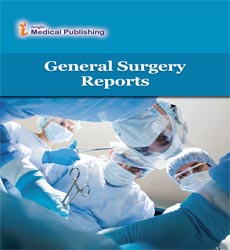Kidney Transplantation can be Performed with Various Careful Methodologies
Jenessa Selim*
Department of Anesthesiology, Ege University, Izmir, Turkey
- *Corresponding Author:
- Jenessa Selim
Department of Anesthesiology,
Ege University, Izmir,
Turkey,
E-mail: Sekim@gmail.com
Received date: August 15, 2023, Manuscript No. IPGSR-23-18469; Editor assigned date: August 17, 2023, PreQC No. IPGSR-23-18469 (PQ); Reviewed date: August 31, 2023, QC No. IPGSR-23-18469; Revised date: September 07, 2023, Manuscript No. IPGSR-23-18469 (R); Published date: September 14, 2023, DOI: 10.36648/ipgsr.7.02.138
Citation: Selim J (2023) Kidney Transplantation can be Performed with Various Careful Methodologies. Gen Surg Rep Vol.7 No.02:138.
Description
Smaller incisions are expected to produce better cosmetic results in KTx recipients without compromising surgical outcomes, surgeons have focused on the length of surgical incisions. KTx patients might have wound recuperating issues because of CKF and the utilization of immunosuppressive specialists, which may unfavorably influence wound mending in view of their enemy of proliferative nature; subsequently, specialists should seriously mull over limiting careful cuts. Studies have shown that immunosuppressive prescriptions. Without compromising the objectives and essential worries of transplantation medical procedure, MIKT can be proposed to chosen relocate patients with restorative worries. The shape and length of entry points might contrast in MIKT relying upon the careful experience of the transfer group. Consensus on the precise definition of incision length in MIKT has not yet been reached. Kidney transplantation can be performed with various careful methodologies, like regular open kidney transplantation, negligibly obtrusive kidney transplantation, laparoscopic kidney transplantation, and robot-helped kidney transplantation.
Renal Transplantation
Regular open kidney transplantation is generally performed utilizing a Gibson or hockey stick cut, might be related with higher injury difficulty rates, and results in more regrettable restorative results contrasted and negligibly obtrusive techniques. In comparison to CKT, minimally invasive kidney transplantation requires a smaller skin incision but may result in less surgical exposure. 37 patients who went through CKT before January 2021 were remembered for bunch 1 (CKT gathering), and 22 patients. Age, sex, and BMI were not significantly different between the groups. In terms of lodge preparation time, vein clamp time, and artery clamp time, there was no statistically significant difference between the groups. Powerful workup and posting of end-stage renal illness patients for renal transplantation, frequently with different co-morbidities, represents a test for relocate groups. Heftiness is a typical codreariness related with unfavorable results in ESRD and kidney relocate beneficiaries. Bariatric and metabolic medical procedure (BMS) has for quite some time been laid out as a protected and powerful therapy for horrible weight. In this review, the creators meant to assess the strength of proof for both the adequacy and wellbeing of bariatric medical procedure in patients with ESRD or kidney transplantation. Determination and workup for kidney transplantation is a profoundly private and critical second in the existence of any persistent experiencing constant kidney sickness. While previous years have demonstrated an average of 3467 kidney transplants per year from 2015 to 2020, 2020 was a pandemic-ravaged year in the United Kingdom, with 1836 kidneys transplanted from deceased donors and 363 from living donors. Nonetheless, north of 3000 individuals keep on sitting tight for a kidney relocate.
Bariatric Medical
In the UK, transplant professionals can get help from guidelines from organizations like the Kidney Disease Improving Global Outcomes (KDIGO), the European Renal Association (ERA), and the NHS Blood and Transplantation Service (NHSBT). However, each ESRD patient's journey is unique, so their workup should be tailored to their requirements. Heftiness (characterized as a weight list (BMI) of 30 kg/m2 or higher) is a huge thought in a patient's reasonableness for kidney transplantation. Worries about chances related with higher BMI can be a boundary to enlistment on renal transfer holding up records. A BMI >35 kg/m2 is related with deferred unite capability and huge careful site diseases, wound inconveniences and post-transplantation diabetes. However settled writing has depicted the significance of weight reduction before KT, there are not many rules on the effect of heftiness on reasonableness for kidney transplantation. Weight is a typical co-dreariness of CKD; with a predominance of practically 45% has been illustrated. The most common surgical procedures are included in this study under the umbrella of Bariatric and Metabolic Surgery (BMS). Gastric detour, Sleeve Gastrostomy (SG), Gastric Banding (GBd) and Duodenal Switch (DS). Bariatric medical procedure is a protected and successful answer for dreary heftiness, impervious to moderate administration. By controlling obesity-related complications like hypertension and type 2 diabetes mellitus, BMS may improve patient outcomes before and after renal transplantation alongside other obesity-related interventions. The test in transplantation is to improve weak patient partners to guarantee the life span of unite endurance. Powerful workup and safe posting of renal disappointment patients for renal transplantation, frequently with different co-morbidities, represents a test for relocate groups. Endstage renal infection patients require satisfactory screening, examination, and clinical survey before safe enrollment on the transplantation holding up list.
Open Access Journals
- Aquaculture & Veterinary Science
- Chemistry & Chemical Sciences
- Clinical Sciences
- Engineering
- General Science
- Genetics & Molecular Biology
- Health Care & Nursing
- Immunology & Microbiology
- Materials Science
- Mathematics & Physics
- Medical Sciences
- Neurology & Psychiatry
- Oncology & Cancer Science
- Pharmaceutical Sciences
